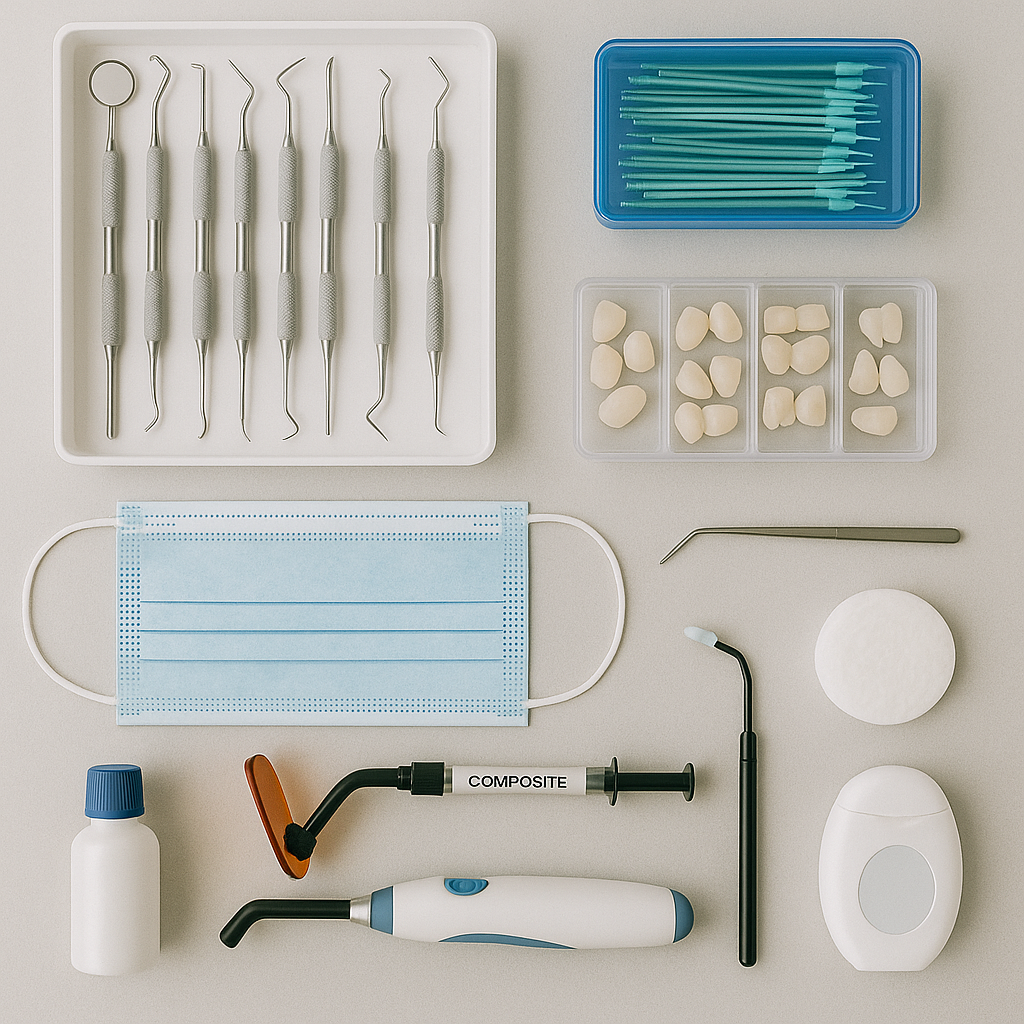It’s perfectly normal to dread dentist visits, even if it’s just a routine cleaning. However, you’ve probably heard horror stories about one type of procedure in particular: dental crowns.
These are a common solution for addressing damaged, weak, or discolored teeth. Most of the time your dentist will use a temporary crown as a placeholder while your permanent restoration is being fabricated at the lab.
You might be wondering…does removing a temporary crown hurt? The good news is you don’t need to stress. This is typically a painless procedure. You might feel a bit of pressure, but it’s rare that a dentist would even bother applying anesthesia.
If you’re still worrying about temporary crown removal pain, keep reading below. We’ll share more insights on removing temporary crown so you can feel more confident leading up to the procedure knowing what to expect.
Overview of Temporary/Provisional Crowns
So what is the purpose of a temporary crown in the first place? These are commonly referred to as provisionals, but no matter what you call them, they serve the same purpose of protecting the tooth while the permanent crown is fabricated.
To appreciate the need for a provisional you need to understand what exactly goes into getting a permanent crown fixed on your tooth. The first step is reshaping a tooth and taking an impression of it, which is then sent off to a lab for fabrication.
In the meantime, that newly shaved-down tooth structure is going to be more vulnerable to sensitivity, decay, and damage. The provisional offers protection in the interim.
This also makes it easier to chew food and speak comfortably, keeping disruptions to the patient’s day-to-day life minimal. Depending on the location of the tooth, a provisional also keeps the patient’s smile intact so they can feel confident in the way they look.
But, perhaps most importantly, the temporary crown prevents shifting of the teeth with the new gap that exists after removing the bulk of the tooth. This would otherwise cause complications with how the permanent crown fits.
You may be wondering, what are temporary crowns made of? There are a variety of materials dental professionals rely on, including acrylic resin or stainless steel. For what it’s worth, we have some of the best temporary crown material in the industry here at My DDS Supply.
So, how long does a temporary crown last? And, how often do temporary crowns fall out on their own? These are topics we explore in our blog if you’re interested in learning more. In the meantime, how is a temporary crown removed?
How is a Temporary Crown Removed?
We wrote a guide a while back on how to make a temporary crown at home, but let’s look at the other side of the coin now - how is a temporary crown removed?
Since these provisionals are bonded with weaker, temporary dental cement, they’re much easier to remove than a permanent restoration would be. Here’s how it works:
Step 1: Preparation
The dentist cleans the area of any debris before getting started removing temporary crowns. They may rinse the mouth with an antiseptic solution to minimize bacteria around the crown.
Step 2: Loosening the Crown
The dentist uses specialized dental instruments, such as a crown remover or hemostat, to gently grasp and manipulate the crown.
Slight rocking or rotating motions are applied to break the temporary adhesive bond. If the crown doesn’t start to loosen easily, the dentist may use an ultrasonic scaler to dissolve or weaken the adhesive further.
Step 3: Removing the Crown
Once the bond is sufficiently weakened, the dentist carefully lifts the crown off the tooth, doing their best to avoid damaging the underlying tooth structure or the adjacent teeth.
You may be wondering, how strong is dental cement? It depends, as there are many types of cements dentists use. But for provisionals, a weaker cement is employed. Our blog talks more about how to remove dental cement if you’re interested.
Step 4: Cleaning the Tooth
After removal, the dentist cleans any remaining adhesive from the tooth and checks the tooth’s condition to confirm it’s ready for the final crown placement.
It’s common for the dentist to apply the permanent crown at this point, but we won’t go into that for the sake of today’s conversation. You came here wondering what to expect in terms of pain and discomfort. So, does removing a temporary crown hurt?
Does Removing a Temporary Crown Hurt?
Like we said earlier, this is typically a pain-free procedure that you don’t need to stress about. Dentists use techniques specifically to minimize discomfort and protect the tooth and surrounding tissues.
While slight pressure or sensitivity still may occur during the process, it won’t be so severe that there’s any need for anesthesia. However, no two provisional removals are the same. Here are some factors influencing how painful the process is:
- Condition of the Tooth: Discomfort is usually minimal if the underlying tooth is healthy. However, sensitivity may be heightened if the tooth has exposed nerves or decay.
- Strength of the Adhesive: Temporary adhesives are weaker than permanent ones, so the force required for removal is much lower. You won’t have to worry about pain from the dentist “prying” the provisional loose.
- Patient Sensitivity: Individuals with sensitive teeth or gums may feel mild discomfort, but this is typically brief and manageable.
Worst case scenario you can tell your dentist you are subject to sensitivity and ask for local anesthetic in the tooth itself or the surrounding area. Your dentist will likely check in with you throughout the process to see how you’re doing and adjust as needed.
However, the entire process of removing temporary crowns takes less than a few minutes. Even if it is a bit uncomfortable, it’s so short-lived that you really don’t have anything to worry about.
Tips on Managing Pain and Discomfort When Removing Temporary Crowns
Maybe you still have your doubts about temporary crown removal pain and you can’t stop yourself from stressing about it.
Communicate that anxiety you’re feeling with your dentist before the procedure. They’ll be able to further dispel your concerns and take additional measures to prioritize your comfort.
That could include applying a numbing gel to the gums for quick, targeted relief without requiring full anesthesia. They may even use ultrasonic tools that apply vibrations to break down the adhesive bonds without as much physical pressure on the tooth structure.
Dentists use slow, deliberate, and controlled movements without any abrupt tugs to keep trauma minimal or non-existent in a best-case scenario. They also use specialized formulations to dissolve or at least weaken the adhesive holding the provisional in place before even attempting to remove it.
If they’re removing your temporary crown, you can reasonably assume they’ve done it time and time again without issue. Trust your dentist to do what’s best for you!
Post-Removal Care
After having your temporary crown removed you’ll be laughing about how quick and pain-free it was, you really were stressing about nothing! But at this point, you’ve also had your permanent crown placed and need to make sure you’re giving it the care it needs. This includes:
- Warm Salt Water Rinse: This can help soothe any irritation caused during the procedure and promote gum healing around the new crown.
- Avoid Irritating Foods: For the first 24 hours after the permanent crown placement, avoid foods that are extremely hot, cold, sticky, or hard. This gives the cement time to fully set.
- Topical Soothing Agents: If you experience mild gum discomfort, you can try using over-the-counter oral gels or numbing creams temporarily. This should subside quickly with proper fit and placement of the permanent crown.
While some initial sensitivity to hot and cold foods is normal after permanent crown placement, prolonged or severe sensitivity should be reported to your dentist to rule out fit or bite alignment issues.
Some dentists may want you to come back to their practice for a follow-up visit to ensure everything looks good and is working as intended, as this will prevent small issues from snowballing into bigger problems.
But at this point, you’re hopefully done sitting in a dental chair for a while!
Parting Thoughts on Temporary Crown Removal Pain
So, does removing a temporary crown hurt? We hope this guide to removing temporary crowns has eased your worries and left you feeling a bit more confident leading into the upcoming procedure. This is a quick, pain-free procedure.
Our blog has more insights on how long does dental cement last, best material for dental face masks, how long to leave gauze in after tooth extraction, how long does dental putty last, dental suture types, dental suctioning techniques, mixing alginate, and many more.
But remember, from temporary crown material to temporary dental cement, the various sterilization pouches sizes, saliva ejectors, or suction devices - My DDS Supply is your one-stop shop for all things dentistry. That includes:
- VPS Impression Material
- Alginate Impression Material
- Dental Mixing Tips
- Dental Impression Trays
- Dental Sutures
- Dental Bibs
- Dental Syringe
- Dental Face Mask
- Dental Putty
- Impression Material
We’re your factory-direct eBay store for all things dentistry. That means you gain access to an extensive catalog of high-quality products at unbeatable prices and world-class customer service from A to Z.
So if you’re a dental professional looking to give your patients the exceptional level of care they deserve, it’s time to rethink your sourcing standards. Set yourself up for success and provide the best possible patient outcomes with our temporary crown materials and other essentials!

